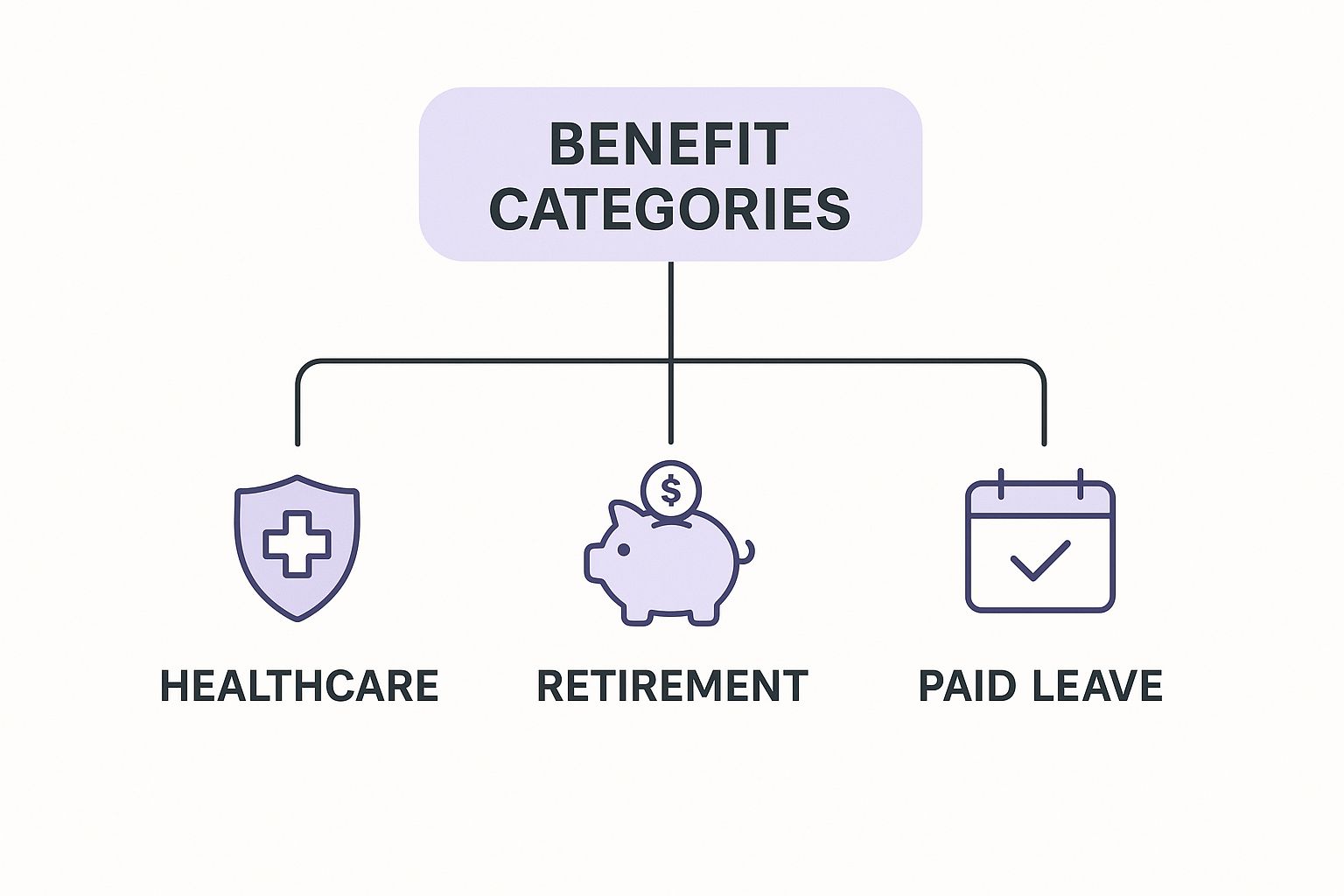
Expanding your business globally is exciting, but it brings a whole new layer of complexity to HR. One of the biggest puzzles to solve? International benefits administration. This isn't just about cutting checks; it's the art and science of managing employee benefits—like healthcare, retirement, and time off—for a team scattered across different countries.
Done right, it's about creating a consistent, supportive experience for your global workforce while carefully navigating a maze of local laws and cultural norms.
Think of yourself as the conductor of a global orchestra. Your company’s core values and benefits philosophy are the sheet music—the single, unifying score everyone follows. But your teams in different countries are the orchestra sections, each with unique instruments, like local regulations, market standards, and cultural expectations.
Your job as the conductor is to make sure every section plays its part perfectly. The result? A harmonious, compliant, and impressive performance that resonates with every employee, no matter where they are. Without this careful coordination, you end up with a mess—a benefits program that feels disjointed, uncompetitive, and, in some cases, non-compliant. A generous health plan in one country might be totally redundant in another with robust public healthcare. Likewise, a standard retirement contribution could fall flat in a market where generous employer matches are the norm.
At its heart, managing global benefits means balancing three distinct categories of employee support. Each one comes with its own rulebook and set of expectations that can change dramatically from one border to the next. For a deeper dive into one of the most common components, you can explore various international private medical insurance options.
Here’s a look at the three pillars of any global benefits program:
This infographic breaks down these core categories visually.

As the diagram shows, foundational elements like healthcare, retirement, and leave are the building blocks of any competitive international program. Getting these pillars right has become a massive global industry for a reason.
To give you a sense of the scale, the table below outlines what each of these core components really involves.
| Component | Key Function | Example |
|---|---|---|
| Statutory Benefits | Ensuring 100% compliance with mandatory, country-specific laws. | Registering employees for Germany's public health insurance or contributing to Brazil's FGTS (unemployment fund). |
| Supplemental Benefits | Designing attractive perks to compete for and retain top talent. | Offering a private dental plan in the UK or a company-sponsored pension plan in Mexico that exceeds the legal minimum. |
| Flexible Benefits | Providing choice and personalization to meet diverse employee needs. | Giving an employee in Spain a benefits wallet they can use for childcare, a gym membership, or extra vacation days. |
| Global Policy & Local Adaptation | Creating a consistent global framework while allowing for necessary local adjustments. | Having a global policy of 4 weeks of paid vacation, but increasing it to 5 weeks in France to align with market expectations. |
Effectively managing these components is no small feat, which is why the demand for expert support is skyrocketing. The global benefits administration service market is projected to grow from US$ 934.7 million in 2025 to a staggering US$ 1,697.7 million by 2032, fueled by ever-rising costs and increasingly complex regulations.

Expanding your business across borders unlocks massive opportunities, but it also throws a whole new set of hurdles your way. When it comes to international benefits administration, there’s no silver bullet. Instead, success means skillfully navigating a tricky landscape defined by three core challenges: regulatory compliance, rising costs, and cultural differences.
Imagine trying to drive, but the speed limits, traffic signs, and even which side of the road to use change every few miles. That’s what compliance feels like for global companies. Each country has its own non-negotiable labor laws, tax codes, and mandatory social security contributions.
A benefit that’s a tax-deductible perk in one nation might be a taxable liability in another. Getting this wrong isn't just a minor slip-up; it can lead to hefty fines, legal trouble, and a black mark on your company's reputation. It’s a compliance minefield that demands constant watchfulness and local expertise.
Beyond compliance, there's the relentless pressure to manage the bottom line. Offering competitive benefits is a must for attracting top talent, but it doesn't come cheap. This financial balancing act has gotten even tougher as global economic forces drive up expenses.
In fact, market data for 2025 shows that inflation and soaring care costs are fueling double-digit increases in benefit plan renewals. This squeeze exposes weaknesses in public healthcare systems, forcing more reliance on private insurance, especially for high-cost claims. You can explore the full findings on market shifts from Brown & Brown to see just how significant this trend is.
This new reality forces difficult decisions. How do you rein in spending without gutting your benefits package and losing your edge in the talent war?
This might be the most crucial challenge of all: recognizing that a benefits plan that’s a home run in your home country is almost guaranteed to strike out somewhere else. Cultural expectations and local norms are what truly shape what employees value.
A generous private health insurance plan might be highly coveted in the United States, but it would be redundant and undervalued in a country like France or Spain, where robust public healthcare systems are the norm.
Understanding these nuances is everything. Here’s why a standardized approach almost always backfires:
Successfully managing international benefits administration means ditching the rigid global template. The goal should be a flexible framework that sets a consistent standard of care while adapting to the unique legal, financial, and cultural realities of each local market.

Staying compliant across different countries isn’t just about avoiding penalties—it's a core pillar of any successful global strategy. When you master the complex web of international regulations, you protect your business from costly missteps and, just as importantly, build a foundation of trust with your global team. Think of it like learning the specific traffic laws for every city you operate in. Ignoring them just isn't an option.
This means you have to stay ahead of major legislative shifts and understand exactly how they affect your benefits and payroll. For instance, with global benefits budgets expected to tighten in 2025, many companies are turning to salary sacrifice schemes for their tax efficiency. Things like pension contributions, cycle-to-work programs, and even electric vehicle schemes are becoming popular tools. At the same time, new rules like the EU Pay Transparency Directive are introducing fresh requirements for pay equity reporting.
A reactive approach to compliance is a recipe for disaster. Instead of putting out fires, you need a proactive system for monitoring and adapting to change. This framework should be built on three core activities that ensure your international benefits administration is always on the right side of the law.
Monitor Legislative Changes: Laws governing benefits, taxes, and labor are always in flux. Setting up alerts or subscribing to updates from legal and HR experts in each country keeps you informed of upcoming changes before they become urgent problems.
Conduct Regular Audits: Schedule periodic compliance audits—at least annually—for each country of operation. These audits should cover everything from payroll deductions and statutory contributions to employment contracts and paid time off policies. For a deeper dive into what this entails, this comprehensive nonprofit compliance checklist is a fantastic resource.
Partner with Local Experts: You can't be an expert in every country's legal system. That's why partnering with local legal and HR consultants is an investment, not an expense. They bring invaluable on-the-ground knowledge to help you navigate tricky local requirements and avoid misinterpretations that could lead to serious penalties.
Compliance doesn't stop at benefits; it extends into every part of the hiring process. Proper vetting is non-negotiable for bringing on reliable and qualified team members, which is why so many organizations rely on professional support. A solid due diligence process, including thorough background verifications, is a cornerstone of any secure global hiring strategy. You can learn more about implementing this in our guide on international background check services.
By treating compliance as an ongoing, strategic function rather than a one-time checklist, you turn a potential liability into a competitive advantage. It demonstrates a commitment to ethical operations and respect for local laws, which strengthens your employer brand worldwide.
Okay, let's move from theory to action. Designing a world-class global benefits program isn't about stamping one country's plan across the map. That never works. Instead, it’s about building a strong, flexible framework that feels globally consistent but also deeply in tune with local needs. This is how you create an international benefits administration that genuinely supports every single employee.
The most successful global companies I've worked with swear by a “global core, local choice” model. Think of it as setting a global minimum standard of care that reflects your company’s values—no matter where someone lives. This core might include a baseline for health coverage, retirement contributions, and paid time off that applies to everyone, everywhere.
But the real magic happens when you customize. Around this global core, you build out flexible options tailored to the specific regulations, market expectations, and cultural norms of each country. This hybrid strategy truly offers the best of both worlds: corporate consistency and local personalization.
Building this framework means shifting your mindset away from rigid, one-size-fits-all policies. You need guiding principles. A global philosophy ensures fairness—not by offering identical perks, but by delivering comparable value and support relative to each local market. This requires getting on the ground, so to speak, and understanding what truly matters to your teams in different regions.
A huge piece of this puzzle is communication. When your teams are scattered across continents, keeping everyone informed and engaged with their benefits is a massive challenge. A centralized technology platform can be a game-changer here, providing a single source of truth for all benefits info. It not only makes life easier for HR but also empowers employees to actually understand and use their benefits. You can find more strategies for keeping global teams on the same page in our guide on how to manage remote teams.
The goal is to create a benefits program that is scalable, equitable, and genuinely valued by employees. It’s a system where an employee in Berlin and an employee in Bogotá both feel equally supported, even if their specific benefits packages look different.
To make your local offerings truly competitive, you absolutely have to benchmark them against local market data. What does a top-tier benefits package look like in Mexico City? What are the standard retirement contributions in the UK? Answering these questions is the only way to ensure you aren’t just compliant but are also seen as an employer of choice.
Here are a few proven strategies you can put into practice right away:
By combining a strong global philosophy with smart, localized execution and crystal-clear communication, you can build a benefits program that truly powers your entire international workforce. This proactive approach to international benefits administration is what separates the good companies from the great global employers.

Trying to juggle compliance, costs, and cultural nuances in international benefits administration can feel like you're constantly playing catch-up. It's a role that often traps HR teams in a reactive cycle of chasing regulatory updates and drowning in paperwork.
But what if you could flip the script? A strategic partner can completely change the game, turning what was once a burden into a genuine competitive advantage. This is where LatHire comes in.
Think of us as your command center for global employment. By acting as an Employer of Record (EOR), we absorb all the thorny legal and administrative work of hiring abroad. Instead of you needing to establish a legal entity in every new country, we become the legal employer for your team members.
This one shift is huge. It solves some of the most stubborn problems in global benefits administration. We take on the responsibility of navigating the tangled web of statutory requirements, ensuring your team gets all their mandated benefits without you having to become an expert in every local labor law.
Our platform doesn’t just keep you compliant; it gives you much-needed clarity and control. Imagine a single dashboard where you can see all your benefits spending, manage payroll across multiple countries, and get a clear picture of your global workforce costs. This is how we empower you to make sharp, strategic decisions instead of getting lost in the weeds.
We handle all the fine print of both statutory and supplemental benefits in each region. This frees up your internal team to focus on what they do best: driving your core business forward. It's especially critical when you're expanding into a new market and don't have that "boots on the ground" expertise.
The EOR model fundamentally de-risks global expansion. It guarantees that from day one, your international team members receive competitive, fully compliant benefits packages tailored to their local market.
By bringing every employment function together on one platform, LatHire removes the friction of managing a distributed team. Here’s a quick look at how our solution directly tackles the challenges we’ve discussed:
This approach doesn't just simplify your day-to-day operations; it fuels your growth. For example, many companies are discovering incredible value by expanding their teams into new regions. Our guide on why hiring remote workers from LatAm is a smart business move dives deeper into this powerful strategy.
With a partner like LatHire, you can finally unlock global talent pools without inheriting all the administrative headaches that usually come with them.
Of course. Here is the rewritten section, crafted to sound like it was written by an experienced human expert, following all your specified requirements.
When you start hiring internationally, a flood of practical questions isn't far behind. The world of international benefits administration can feel like a minefield, but breaking it down into real-world scenarios makes it much easier to navigate. Here are the straight-up answers to the questions we hear most often from companies building their global teams.
Hands down, the most common mistake is trying to force a one-size-fits-all benefits plan across different countries. So many companies just try to replicate their domestic package abroad, and it almost always backfires. They completely overlook the massive differences in local laws, statutory requirements, and what people actually value.
For example, a top-tier private health plan is a huge selling point in the U.S. But in a country with a fantastic public healthcare system, like Spain or France, it's often redundant. This slip-up doesn't just waste money; it makes the company look disconnected from local realities, which can sink morale and make it nearly impossible to keep your best people.
A winning global benefits strategy is never a copy-paste job. It’s built on thoughtful local research and careful customization to give employees real value and keep the business protected.
Managing costs isn't about making blunt, painful cuts—it's about being strategic. First, you need to know where your money is going. Use data to pinpoint what’s driving costs, like high claims for certain health issues. Once you know that, you can launch targeted wellness programs to improve long-term health and bring those claims down.
Next, look for tax-smart ways to offer perks. Things like salary sacrifice schemes, where employees can contribute to pensions or other benefits before taxes, are a great option. And finally, just ask your team what they actually want. You might be shocked to find you're overspending on benefits they don't care about while missing the mark on things they truly desire, like flexible hours or better mental health support.
Think of an Employer of Record (EOR) like LatHire as your in-country HR partner. It’s a third-party organization that legally employs your international staff on your behalf. This is an absolute game-changer for international benefits administration because the EOR takes on all the formal employment headaches.
An EOR manages everything from payroll and tax withholding to, most importantly, providing statutory and supplemental benefits that are 100% compliant with local laws. You get to skip the nightmare of setting up your own legal entity in every country just to hire someone. The EOR makes sure your team gets competitive, compliant benefits right from day one, which takes a huge amount of risk and complexity off your plate.
Achieving true equity isn't about giving everyone the exact same perks. It’s about delivering comparable value. The first step is to sit down and create a global benefits philosophy—a clear framework that spells out your company’s commitment to your team's well-being, no matter where they live.
From there, you have to do your homework. Benchmark the local market in each country to figure out what a truly competitive package looks like there. The goal is to ensure an employee in Germany receives benefits that are just as attractive and supportive, relative to their local market, as an employee in Brazil. This could mean offering robust private health insurance in one region and beefed-up retirement contributions in another. It’s a delicate balance, and keeping it requires regular reviews and, most importantly, listening to your people.
